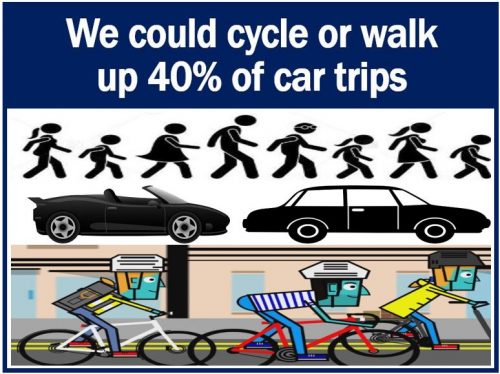Is it possible for us to switch from cars to cycling or walking? Up to forty percent of our car trips are short, say researchers from Universidad Politécnica de Madrid in Vitoria Gasteiz, Spain. Most of us could easily do those trips either on foot or cycling. The research team also identified what people who travel by car perceive as barriers.
The researchers say their findings contain valuable data for policymakers who want to reduce car usage. Specifically, to encourage the replacement of cars by other non-motorized modes of transport for short trips.
The research team focused their study on car usage in Vitoria-Gasteiz. Vitoria-Gasteiz is the capital city of the Basque Autonomous Community in northern Spain.
Javier Delso, Belén Martín, and Emilio Ortega wrote about their study in the journal Sustainability (citation below).
Drivers who can switch to cycling or walking
They first assessed the percentage of car drivers who could potentially have switched to walking or cycling.
Based on the results of a mobility survey, the researchers calculated how far people were willing to travel using ‘active modes.’ By ‘active modes,’ the research team means ‘cycling or walking.’
They found that people were willing to walk and cycle up to 1.6 km (1 mile) and 3.5 km (2.17 miles) respectively.
Belén Martín said:
“Results suggests that, in Vitoria-Gasteiz (Spain), around 20% of car trips could have made on foot and up to 40% by bicycle.”

Barriers to cycling
The researchers then tried to identify the barriers that made car drivers’ reluctant to switch to cycling They focused on short trips, i.e., trips deemed short enough for cycling.
The research team identified the following barriers:
- Personal safety.
- Lack of cycle lanes. (Infrastructure problem)
- Lack of parking spaces. (Infrastructure problem)
- Bicycle maintenance issues, such as repairs.
Infrastructure refers to all the systems and structures a country has that most of us take for granted. Railways (US: railroads), roads, street lighting, traffic lights, tunnels, and bridges, for example, are items of infrastructure.
Javier Delso said:
“The obtained results provide valuable information for policymakers and city council staff. Both the obtained distance thresholds and the percentage of short car trips potentially replaceable can help define transport regulations.”
“The analysis results of the perceived barriers can be used to study the most suitable measures to boost the switch from car to bicycle for short trips.”
Citation
“Potentially Replaceable Car Trips: Assessment of Potential Modal Change towards Active Transport Modes in Vitoria-Gasteiz,” Javier Delso, Belén Martín, and Emilio Ortega. Sustainability 2018, 10(10), 3510. DOI: https://doi.org/10.3390/su10103510.
